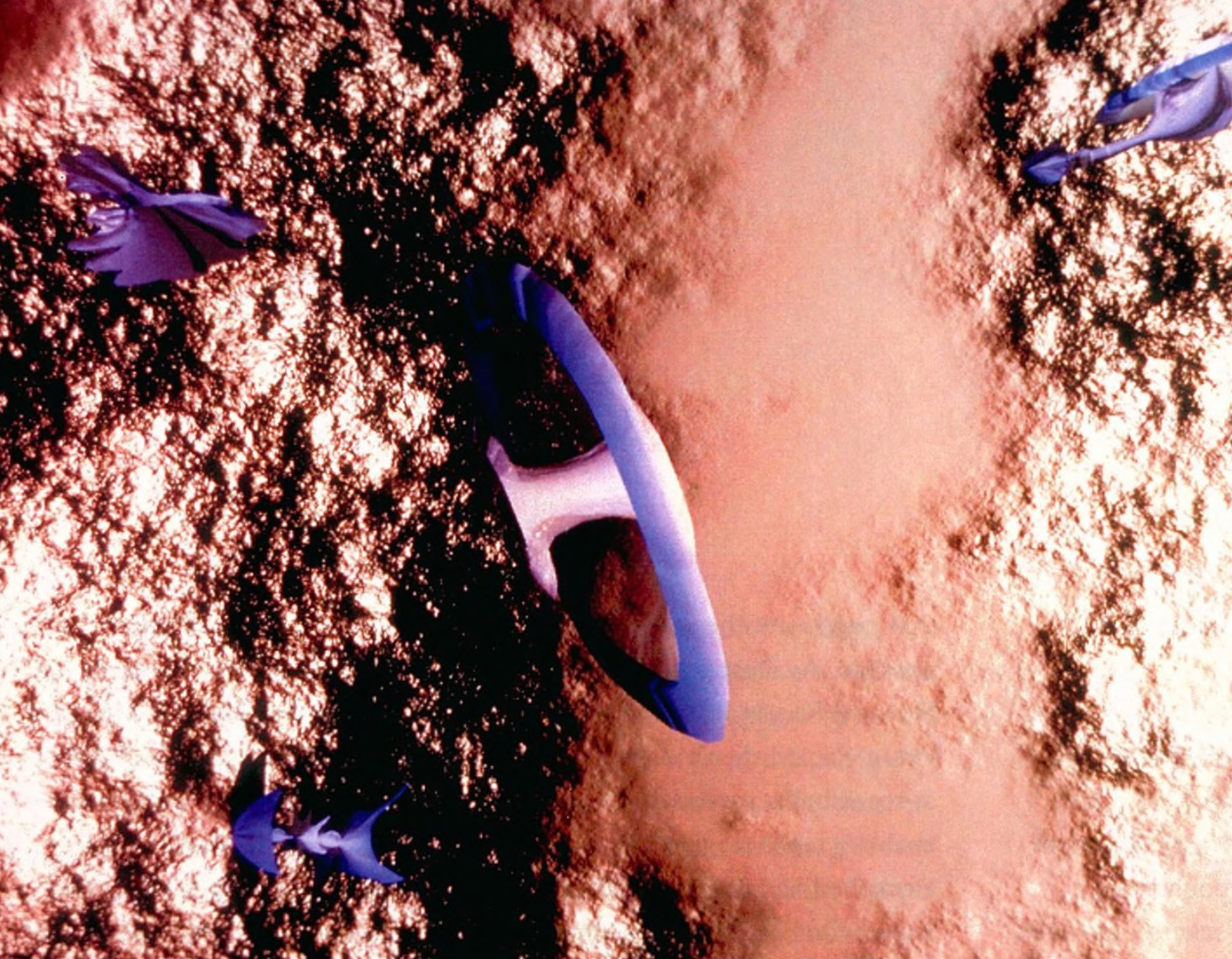“A-Volve A real-time interactive environment” by Sommerer and Mignonneau
Conference:
Experience Type(s):
Entry Number: 01
Title:
- A-Volve A real-time interactive environment
Program Title:
- The Edge
Organizer(s)/Presenter(s):
Collaborator(s):
- National Center for Supercomputing Applications
- Intercommunication Center
- NTT
- Tom Ray
- ATR Human Information Processing Research Laboratories
Project Affiliation:
- National Center for Supercomputing Applications (NCSA)
Description:
A-Volve is an interactive environment where visitors interact with virtual organisms in the real space of a water-filled glass pool. Using a sensor pencil, they draw the profile and shape of any possible form onto a monitor screen and create three-dimensional organisms. The organisms are simultaneously transferred and displayed as three-dimensional creatures in the water of the pool, where they are immediately “alive.? They move and swim, and they can be modified in real time. These virtual creatures are products of the rules of evolution and are influenced by human creation and decisions. They are sensitive to hand movements in the water, and they react to human behaviour. Visitors can catch them, modify their forms, and communicate with them in real time.
When it is ?touched,? a creature will avoid the hand and try to flee. Sometimes, it will come back to ?play?. Each creature moves, reacts, and evolves according to its original design, so it creates unpredictable and always new life-like behaviour. Since the organisms capture the slightest movements of hands in the water, their form and behaviour change constantly.
Specific algorithms developed by Mignonneau and Sommerer ensure that the virtual creatures move very smoothly and animallike. None of the forms is precalculated; they are all ?born? in real time by visitor design, and they achieve their behaviour by moving in the real-water environment. If nobody is creating any forms or interacting with them, the creatures die and disappear.
These living, reacting organisms also interact with other organisms created by other visitors. Two forms can merge and create a new form, which combines the genetic codes of its parents. Visitors can promote the ?birth? of a new organism. With their hand movements in the water, they can ?join? two organisms by trying to bring them near to each other. When they succeed, a new organism is born. The new creature, which carries significant characteristics of both parents, lives in the pool, where it interacts with its environment and other forms.
The drawing device, which creates new forms, can be used by only one person at a time, but several other visitors can interact with the creatures in the pool as new creatures are created. At the same time, visitors interact with each other through the various virtual organisms.
In this virtual environment, the visitor is part of the evolutionary system, a partner of the virtual organisms, and a creator and promoter of ?artificial life.? Following the laws of evolution and creation, A-Volve is open to all possible modifications and selections. It reduces the borders between real and unreal, by connecting reality to ?non-reality.? Water, the medium for this artificial life ?pool,? is the metaphor for birth and basic evolution.
A-Volve is part of a continuing investigation of natural interfaces and complex interactivity. Similar to ?Interactive Plant Growing? (? 1992, Sommerer &
Mignonneau), where visitors could interact with real plants and influence and control the growth of virtual three-dimensional plants, A-Volve deals with the definition of ?life” and the connection between ?reality? and ?non-reality?.
Both installations reveal human perception of reality by interpolating between both constitutions of environments (?real? and ?non-real?). Complex natural interfaces (like plants or water) ensure a new approach to perception by asking: “What is Life??. In both installations, complex systems like ?human and plants? and ?human and animal-like creatures? are connected through living interfaces, producing a complex ?artificial biotope? that represents the interaction between visitors and their environment.
Another important aspect of this work is the issue of ?individuality? as a main constitution of life. AVolve connects the individuality of the visitors to the individuality of the artificial creatures, creating a pool of artificial individuals in a complex system of interactions. The individuality of the virtual creatures is, so to speak, a direct interpretation of the relationship between visitors and their perception of artificial reality. The creatures will always be different, depending on how visitors create them and play with them. Direct and simultaneous communication between creatures and visitors creates a pool that could itself be considered a ?living system.?
By closely connecting the real natural space of the water to the unreal virtual space of the creatures, A-Volve minimizes the borders between ?real? and ?non-real,? creating a further step (after ?Interactive Plant Growing?) in the search for ?natural interfaces? and ?real-time interaction.?





